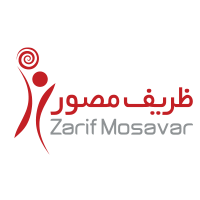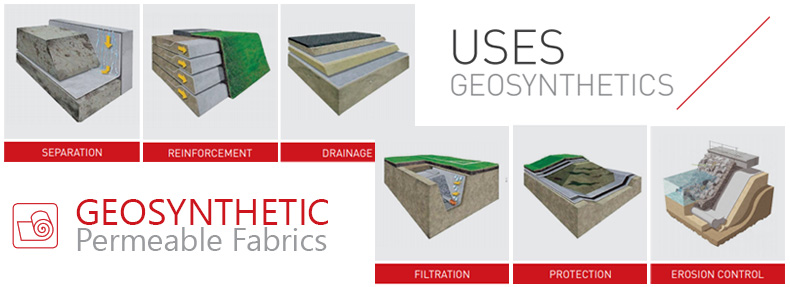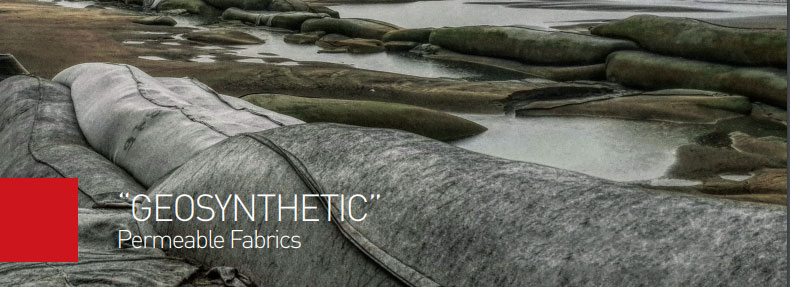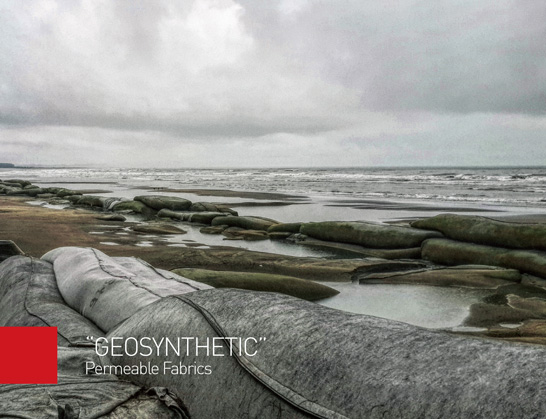applications geosynthetic, permeable fabrics
Most of these applications are not technical in comparison to a beach reclamation system or a retaining wall, but they are practical and cost-efficient applications of Geosynthetics, and their uses are growing.
Geotextiles are permeable fabrics which, when used in association with soil, have the ability to separate, filter, reinforce, protect or drain. They have a wide range of applications and are currently used to advantage in many civil engineering applications including roads, airfields, railroads, embankments, retaining structures, reservoirs,canals, dams, bank protection and coastal engineering. Since polypropylene geotextiles perform well when exposed to water and other inorganic compounds, they are for uses such as pond liners, bank weed control, liners for garden fountain systems, filtra-tion, dividers in ponds, pile wraps, lagoon liners, turbidity curtains, or as in this case, an artificial habitat.
USES GEOSYNTHETICS
REINFORCEMENT:
Geosynthetics are installed beneath or between soil layers to improve the mechanical properties of soil layers by absorbing the tensile forces and minimising deformation. Geotextiles are used in applications such as retaining structures according to the principles of «reinforced soil», slope stabilization or for foun-dation reinforcement of earthen dams where the subsoil exhibits poor bearing capacity.The use of geosynthetics for reinforcement applications minimises expensive constructive measures and can reduce soil intermixing eliminating the need for additional soil layers.
SEPARATION:
As a separation layer, nonwoven geotextiles are used to prevent adjacent soil layers or fill materials from intermixing. Nonwoven geotextiles that exhibit a high elongation capacity are the materials of choice in most applications. The selection of a suitable product is dependent upon the base course grain size and the operational loads to be expected. The main use of separation nonwovens are road and railway construction, hydraulic and landfill engineering and sport fields.
DRAINAGE:
In the EN ISO standards, the drainage function is defined as «The collecting & transporting of precipitation, ground water and/or other fluids in the plane of the geotextile». Hydraulic properties are decisive for the overall performance of the entire construction, with the water flow capacity in the plane of the geotextile being the most important. The hydraulic properties of Zarif mosavar Geotextiles are designed to drain excess water off the construction – not by passing through the Zarif mosavar Geotextile as when used for filtration, but by flowing in the plane of the geotextile leading it away from the construction. The use of a drainage geotextile ensures ongoing drainage of fluids with minimum pressure loss.
FILTRATION:
In filtration applications such as hydraulic engineering and drainage systems, nonwoven geotextiles are used to retain soil particles while allowing the passage of liquids through the filter media. There are two aspects to filtration that should be evaluated when designing. The mechanical filter efficiency (does the fabric have sufficient soil retention capacity) and the hydraulic filter efficiency (does the water discharge without a hydraulic pressure build up). As with mineral filter layers, the geotextile thickness directly benefits the long-term mechanical and hydraulic efficiency of the filter.
CONTAINMENT:
Geosynthetic containment applications are those in which a textile in the form of a tube, bag or container, is used to encapsulate a construction material, such as soil or sand. They perform project-specific functions such as protection, filtration and separation. Nonwoven geotextiles are the primary products for these applications due to their high elongation capacity.
PROTECTION:
Geomembranes, structures, coated materials as well as related construction elements must often be protected from potential mechanical damage. Without suitable protection damage may occur from sharp edged objects such as stones due to the unevenness of the subsoil or even by the cover material. Mechanically bonded needle-punched nonwovens manufactured from polypropylene (PP) or polyester (PET) fibers are commonly used for protection layers. Specific to nonwoven geotextiles, the protection function is directly related to the thickness and mass per unit area, as a heavier and thicker nonwoven is more likely to provide better protection.
EROSION CONTROL:
Geotextiles are used to prevent surface erosion. By preventing soil particles from being washed off slopes or channels, rapid vegetation is ensured when erosion control mats are used.
APPLICATIONS GEOSYNTHETICS:
Roads, Railways, Drainage Systems, Embankment Erosion, Landfills, Tunnels & Underground, Pipeline Protection, Shore & River Line Protection.



